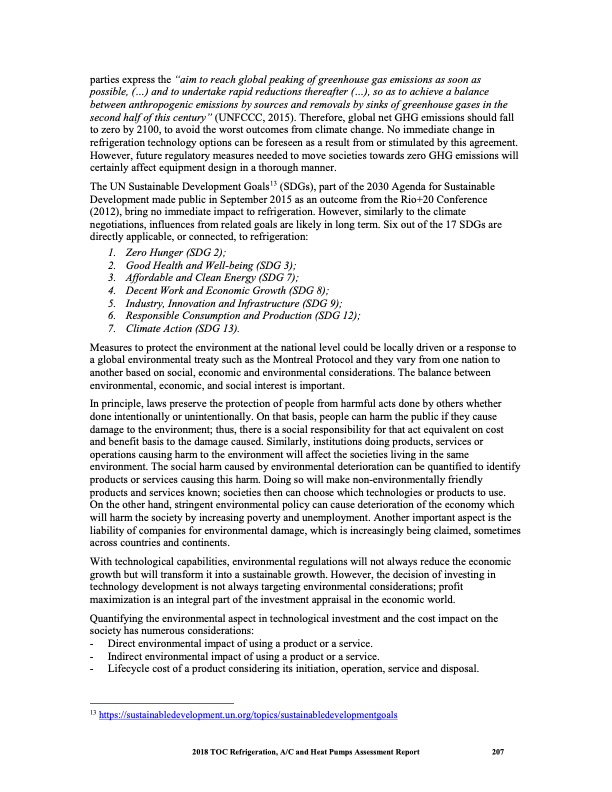
PDF Publication Title:
Text from PDF Page: 220
parties express the “aim to reach global peaking of greenhouse gas emissions as soon as possible, (...) and to undertake rapid reductions thereafter (...), so as to achieve a balance between anthropogenic emissions by sources and removals by sinks of greenhouse gases in the second half of this century” (UNFCCC, 2015). Therefore, global net GHG emissions should fall to zero by 2100, to avoid the worst outcomes from climate change. No immediate change in refrigeration technology options can be foreseen as a result from or stimulated by this agreement. However, future regulatory measures needed to move societies towards zero GHG emissions will certainly affect equipment design in a thorough manner. The UN Sustainable Development Goals13 (SDGs), part of the 2030 Agenda for Sustainable Development made public in September 2015 as an outcome from the Rio+20 Conference (2012), bring no immediate impact to refrigeration. However, similarly to the climate negotiations, influences from related goals are likely in long term. Six out of the 17 SDGs are directly applicable, or connected, to refrigeration: 1. Zero Hunger (SDG 2); 2. Good Health and Well-being (SDG 3); 3. Affordable and Clean Energy (SDG 7); 4. Decent Work and Economic Growth (SDG 8); 5. Industry, Innovation and Infrastructure (SDG 9); 6. Responsible Consumption and Production (SDG 12); 7. Climate Action (SDG 13). Measures to protect the environment at the national level could be locally driven or a response to a global environmental treaty such as the Montreal Protocol and they vary from one nation to another based on social, economic and environmental considerations. The balance between environmental, economic, and social interest is important. In principle, laws preserve the protection of people from harmful acts done by others whether done intentionally or unintentionally. On that basis, people can harm the public if they cause damage to the environment; thus, there is a social responsibility for that act equivalent on cost and benefit basis to the damage caused. Similarly, institutions doing products, services or operations causing harm to the environment will affect the societies living in the same environment. The social harm caused by environmental deterioration can be quantified to identify products or services causing this harm. Doing so will make non-environmentally friendly products and services known; societies then can choose which technologies or products to use. On the other hand, stringent environmental policy can cause deterioration of the economy which will harm the society by increasing poverty and unemployment. Another important aspect is the liability of companies for environmental damage, which is increasingly being claimed, sometimes across countries and continents. With technological capabilities, environmental regulations will not always reduce the economic growth but will transform it into a sustainable growth. However, the decision of investing in technology development is not always targeting environmental considerations; profit maximization is an integral part of the investment appraisal in the economic world. Quantifying the environmental aspect in technological investment and the cost impact on the society has numerous considerations: - Direct environmental impact of using a product or a service. - Indirect environmental impact of using a product or a service. - Lifecycle cost of a product considering its initiation, operation, service and disposal. 13 https://sustainabledevelopment.un.org/topics/sustainabledevelopmentgoals 2018 TOC Refrigeration, A/C and Heat Pumps Assessment Report 207PDF Image | Heat Pumps Technical Options

PDF Search Title:
Heat Pumps Technical OptionsOriginal File Name Searched:
RTOC-assessment-report-2018_0.pdfDIY PDF Search: Google It | Yahoo | Bing
CO2 Organic Rankine Cycle Experimenter Platform The supercritical CO2 phase change system is both a heat pump and organic rankine cycle which can be used for those purposes and as a supercritical extractor for advanced subcritical and supercritical extraction technology. Uses include producing nanoparticles, precious metal CO2 extraction, lithium battery recycling, and other applications... More Info
Heat Pumps CO2 ORC Heat Pump System Platform More Info
| CONTACT TEL: 608-238-6001 Email: greg@infinityturbine.com | RSS | AMP |